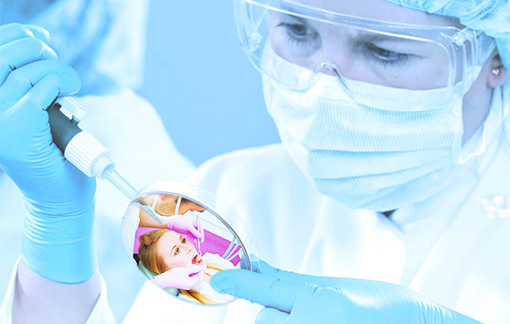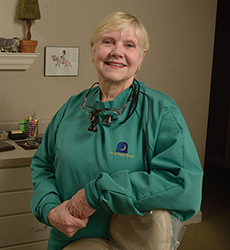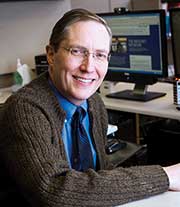Local Heroes Help Turn Dental Problems into Solutions
By Dale Short

Some vexing health questions can be answered with a new machine or dazzling technical insight. Others require a simpler tool: time.
“How can you tell whether a tooth needs filling immediately or not?” says UAB alumna Kaye Shaw, D.M.D., who practices family dentistry in the town of Fairhope on Alabama’s Gulf Coast. “The research might involve observing a tooth closely for anywhere from six months to two years.”
 Kaye Shaw is one of several UAB
Kaye Shaw is one of several UABalumni participating in a massive
research effort to broaden the
knowledge base for 21st century
dentists.
Shaw is helping to answer dental conundrums just like that one. She is one of many UAB dental alumni who are collaborating on a massive research project made possible by the largest grant in the university’s history. The program, known as the National Dental Practice-Based Network, is a seven-year, $66.8-million program connecting the National Institute of Dental and Craniofacial Research—a part of the National Institutes of Health—with a network of local dentists in six regions from Portland, Oregon, to Gainesville, Florida.
“We hope to improve the nation’s oral health by improving the knowledge base for clinical decision-making and moving the latest evidence into routine care,” says principal investigator Gregg Gilbert, D.D.S., M.B.A., professor and chair of the UAB Department of General Dental Sciences. The network, Gilbert explains, is “a unique investigative union of real-world practicing dentists and academic scientists.” Practicing dentists suggest problems—and provide data and observations; UAB researchers investigate solutions and communicate these back to the practitioners. Research topics already in the works include everything from “Persistent Pain and Root Canal Therapy” to “Assessing Outcomes of Cracked Teeth.”
Everyday Answers
“The whole purpose of the network is to help answer the kinds of questions that arise in an everyday dental practice,” says Sonia Makhija, D.D.S., M.P.H., associate professor of behavioral and population sciences in the UAB Department of Clinical and Community Sciences and director of communications and dissemination for the network. “Because so many dentists work solo, they’re often not aware of what everybody else is doing."
 Gregg Gilbert
Gregg Gilbert
“Our profession has a really good starting base of knowledge,” says UABSOD alumnus Gerald Anderson, D.M.D., who practices in his hometown of Selma, Alabama. “But we know there are always better ways of doing anything, whether it’s new materials or new techniques. So it’s important for us to keep getting better at recognizing what patients want and delivering the care they need and expect.”
One recent study in the program examined "questionable lesions"—"a spot on the tooth that you’re not sure initially is a cavity or is something else,” Makhija says. “There had never been a study of just how frequently these lesions are seen in dental visits, and it turned out to be somewhere around a third of the time, which is a very high prevalence.
“When the tooth was opened to put in a filling, about half ended up as cavities so small they could have been prevented without opening the tooth," Makhija continues. "So one thing we learned is to think twice about opening a tooth because that can impact the life cycle of the tooth, sometimes requiring bigger fillings.
“So we’ve tried to change the behavior from a traditional response of ‘drill-and-fill’ to really monitoring and doing an ongoing risk assessment of the patient—considering whether a patient’s diet is high in sugar, whether they live in a fluoridated area, how regularly they come in for cleanings, and so on.”
The understanding the researchers gain will directly help patients by reducing both their fears and the amount of money they have to invest in maintaining the health of their teeth. “The evidence is showing that the more regularly they visit,” Makhija says, “the less likely they’ll require fillings. So patients might be spending a little more in the short run to get cleanings, but will pay less in the long run by not having to have the tooth taken out. So that’s a message we’re trying to communicate not just to dental professionals but to patients as well.”
UAB at the Hub
The NIDCR launched its first practice-based initiative in 2005, supporting three regional networks—including one at UAB—each with its own affiliated practitioners, administrative setups, and clinical studies. The effort’s new incarnation, headquartered at UAB, leads and oversees six smaller regional research centers located in Birmingham; San Antonio, Texas; Minneapolis, Minnesota; Portland, Oregon; Rochester, New York; and Gainesville, Florida.
NIDCR director Martha Somerman, D.D.S., Ph.D., says the coordination of the resulting “hub-and-spoke” structure “should free up those at the regional sites to focus almost solely on research, creating an excellent opportunity for everyone.”
UAB School of Dentistry Dean Michael Reddy, D.M.D., D.M.Sc., agrees. “This network gives the people providing the bulk of dental care a voice in the science behind patient care. And we’re thrilled that the UAB School of Dentistry has been selected to lead this important national research effort.
“We’re poised to transform oral health and dental education and be a model for all health-care education," says Reddy, "which I firmly believe will change the practices of the future.”
Relational Research
“I tell my patients that even though I’ve been doing this for 29 years, I still don’t know everything, believe it or not,” says Shaw. “Once they hear about the various research projects they can participate in, they’re very responsive and seem excited that they can be a part of this effort on a national scale. They realize that it’s something bigger than just going to the dentist.”
Another benefit: “It’s easy for the patients,” Shaw says, “because all they have to do is keep their teeth clean and hope we won’t have to do anything.”
Shaw is able to count on her patients’ trust, seeing as how they are together for the long haul. “If you’ve seen somebody regularly for 20 years, you know whether they look healthy or not,” she says. “I saw a gentleman recently and mentioned to him that his color didn’t look good. He went for a checkup and found that his blood pressure was through the roof, so they were able to intervene.”
Treating multiple generations of patients has only one downside, Shaw says. “When someone you’ve cared for passes away, it’s like losing a member of your extended family. Just last Sunday, a woman whose husband had died asked me if I’d come to their home and help her clean out his office. You don’t just know your patients by name. They’re part of your life.”
Shaw sees her investigations with UAB as simply another part of her patient-care efforts. “What our research is always trying to find out is what’s in a patient’s best interest, long-term,” she says.
—This story originally appeared in a longer form in the Winter 2013 issue of UAB Dentistry, the magazine of the UAB School of Dentistry